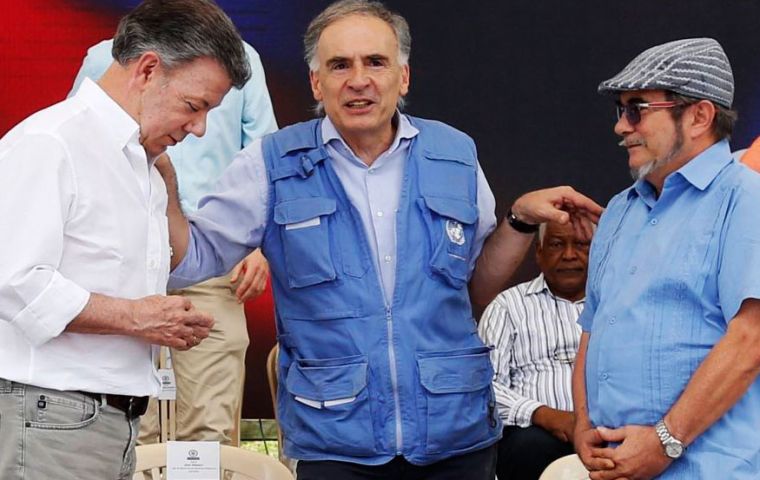MercoPress. South Atlantic News Agency
FARC hands over weapons, prepares for the political phase of peace accord
 Jean Arnault, U.N. representative for the Colombian peace process, center, talks to Colombia's President Juan Manuel Santos, left, and Rodrigo Londoño, the top commander of the FARC (Pic UN)
Jean Arnault, U.N. representative for the Colombian peace process, center, talks to Colombia's President Juan Manuel Santos, left, and Rodrigo Londoño, the top commander of the FARC (Pic UN) U.N. observers on Tuesday removed the last of more than 8,000 guns once carried by the guerrillas of Colombia’s largest rebel army and collected at 26 demobilization sites around the South American nation under a historic peace deal. The next phase of the peace deal is for the ex guerrillas to organize politically and run for seats in congressional elections.
Rebels agreed to disarm as part of the pact reached with the government last year, and some of the weapons will be smelted and transformed into statues commemorating the end to Latin America’s longest-running armed conflict.
“This puts the country on the path to a new future,” Jean Arnault, head of the United Nations’ mission in Colombia, said at a ceremony where President Juan Manuel Santos put a lock on the final container as leaders of the Revolutionary Armed Forces of Colombia, or FARC, looked on.
Former FARC rebels finished turning over their individual weapons in late June, and since then the guns have been locked up and guarded by U.N. observers. On Tuesday the last remaining container was taken from a transition zone in northern Colombia.
In addition to some 8,112 guns, Arnault said the United Nations collected 1.3 million bullets, 22 tons of explosives, 3,000 grenades and 1,000 land mines from the rebels.
“Building peace is like building a cathedral, and today we are laying the foundation,” said Santos, winner of last year’s Nobel Peace Prize for his efforts to win an end to hostilities.
In another sign of the FARC’s transition, the International Committee of the Red Cross said Tuesday that 24 child fighters were received at seven rebel camps. Since the peace deal was signed, the FARC has turned over a total of 112 teenage fighters to the Red Cross.
The FARC was formed in the early 1960s by guerrillas affiliated with Colombia’s communist party intent on resolving longstanding issues such as land disputes and government neglect of rural areas, issues that still resonate in much of the nation today.
Over the next five decades, the conflict between the rebels, government forces and right-wing paramilitaries claimed at least 250,000 lives and left another 60,000 people missing. Millions more were displaced from their homes fleeing the bloodshed.
The handing over of rebel arms is a fundamental component of the peace accord, which also aims to reduce Colombia’s booming coca production by encouraging farmers to grow food crops instead and expand the state’s presence in remote areas where basic utilities like running water and electricity can be scarce.
The rebel leader known by the nom de guerre Ivan Marquez took advantage of the media attention on Tuesday’s ceremony to preview what he said is likely to be the name of the former rebels’ new political movement: the Revolutionary Alternative Force of Colombia, preserving the Spanish acronym FARC.
“We will be part of the system but raise our voice clearly and sharply against the system,” Marquez said.




Top Comments
Disclaimer & comment rulesCommenting for this story is now closed.
If you have a Facebook account, become a fan and comment on our Facebook Page!